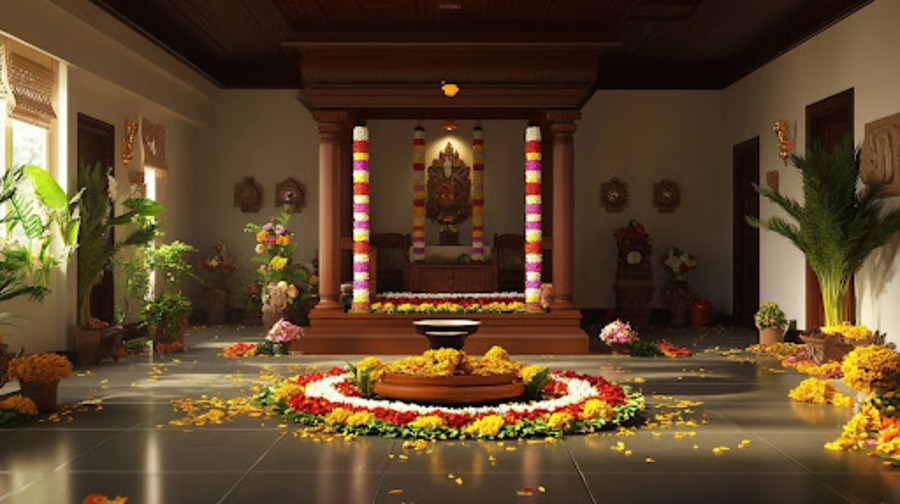
Fix Pooja Room Vastu Doshas with These 14 Tips
In India, the pooja room is considered a sacred space—a quiet corner meant for connection, prayer, and peace. But sometimes, even with the best intentions, the energies in this space may feel off. This could be due to small things that go unnoticed—like the direction the idol is placed, the material used for the mandir, or even what is stored nearby. These unnoticed details often result in pooja room vastu doshas, which are imbalances that may disrupt the positive energy flow in the home. Thankfully, these doshas can be corrected with mindful changes, without the need to renovate the entire space.
A Sacred Space That Needs Balance
When we think of the pooja room, it’s not just a decorative corner but an important spiritual zone in the house. However, when Vastu principles are not followed correctly—such as placing the pooja unit in the wrong direction or using inappropriate elements like mirrors or dark colours—it can affect the overall energy. These imbalances, or pooja room vastu doshas, are known to impact the peace and harmony of the home. They might seem small or insignificant at first, but over time, their influence becomes more visible in subtle ways—restlessness, constant tension, or simply a feeling that something is not quite right.
What makes Vastu correction so helpful is that it doesn’t always demand a large-scale change. Sometimes, it’s about paying attention to what already exists and shifting elements with intention. The pooja room, being a high-energy area, responds well to these changes when done with care. For example, the placement of sacred symbols, the alignment of the lamp, or the use of calming tones and natural materials can gradually bring back balance.
When Small Shifts Make a Big Difference
You don’t always need to move walls or reconstruct your space to fix the pooja room vastu doshas. In many cases, the solution lies in realigning the energy through simpler changes. If your pooja unit is placed in the south or southwest corner of your house, shifting it toward the northeast—even if it’s just by a few feet—can make a noticeable difference in the overall atmosphere. Likewise, replacing synthetic materials with wood or marble, using soft warm lighting, or adding subtle elements like copper diya stands or fresh flowers can instantly uplift the energy.
It is also essential to ensure that the pooja room is used solely for spiritual practices. Often, due to space constraints, people end up using this area for storage or placing electronic items nearby, which can interfere with the energy. Keeping the space clutter-free and clean not only honours its spiritual purpose but also helps correct the imbalance. You might be surprised to see how restoring even a bit of order in this room can slowly extend a sense of calm across the rest of your home. Many clients seek the help of a home interior design expert in Mumbai to incorporate such elements harmoniously into their existing décor.
One more thing that plays a vital role in correcting pooja room vastu doshas is lighting. A poorly lit pooja space can feel heavy or inactive. Natural light is best, but if that’s not possible, you can use soft, yellow lighting or an oil lamp that burns daily. A diya or lamp placed on the right side of the idols and kept clean regularly not only adds to the visual calmness but also aligns with many traditional Vastu recommendations.
A Home that Breathes with You
Homes that feel good are homes that breathe with their inhabitants. And the pooja room is often the lungs of that spiritual breath. So, when things feel stagnant, off-balance, or tense, it’s worth considering whether your sacred space is truly aligned with your intention and energy. Correcting pooja room vastu doshas isn’t just about ticking off a checklist. It’s more about asking if your space feels harmonious, whether you feel mentally calm when you sit there, and if the energy of that corner supports your daily emotional and spiritual rhythm.
In many ways, these changes become part of a quiet routine. Lighting the lamp at the same time every evening, keeping the area clean, ensuring fresh flowers are added, and making time to sit in silence—even for a few minutes—can all become ways of slowly restoring balance not just in the room, but in your daily life. These aren’t dramatic changes. They are subtle. But they create a shift over time. They begin to influence how you interact with your surroundings, how your space responds to your mood, and how others in the home feel the difference too.
And while ancient texts and guides offer specific do’s and don’ts, it’s the intention behind the changes that holds the real value. The effort to nurture that space with care—through sound, light, fragrance, and stillness—has a ripple effect. You may notice improved sleep, less tension in your interactions, or simply a deeper connection to the rituals you follow. That is how space begins to work with you, not against you.
Sometimes, people think fixing Vastu doshas is complicated or expensive. But the truth is, it doesn’t have to be. With a little attention and intention, it becomes an intuitive process. A process that reflects how you want to live and feel in your own home.
This understanding, when it becomes a natural part of your day, has the power to bring not just peace to the pooja room but also to every other room around it. A Vastu-based interior solution curated by professionals ensures this balance flows across the entire home seamlessly.
A Vastu-based interior solution curated by professionals ensures this balance flows across the entire home seamlessly. To explore more ideas on aligning your home spaces for peace and well-being, visit Rennovate.






